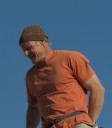Tap Dancing at Whole Foods on Earth Day
Whole Foods is, according to a hilarious (and all too true) daily calendar “Stuff White People Like“, the ultimate epiphany of olive bar congregation, hand lotion sampling, and coffee, bread, wine and cheese tasting for those who want everyone else to know they are doing the right thing.
To have stumbled into Whole Foods on Earth Day should be, according to the 365 tear-off pieces of paper, a cosmic orgasm of organic ecstasy to save Planet Earth, one echinacea infused, rose hip and lavender bottle of carrot juice at a time.
Quite frankly, I found it a bit overwhelming and would have run away were it not for the incredible variety of free samples of chocolates, breads, cheeses, and pastries. I nearly abandoned my plans for dinner, realizing that just two or three rounds, from end-cap to end-cap would likely suffice for a complete, 3-course meal.
At the table for Zinger brand trail bars, I enjoyed a few samples which reminded me of Bit-O-Honey candy when I was a kid, the rich flavor of honey so much preferred over any variety of processed sugar.
But on the right most paper lined dish was an assortment of red blobs, the diameter of a quarter and roughly half the height at the peak of their shiny, waxy dome. If the woman serving the samples had not explained that they were a new kind of “power shot”, I would have assumed someone failed to recover a highly displaced Christmas tree ornament box, its contents spilled neatly on this end-cap at Whole Foods.
At her request for me to try a sample, I shook my head stating it just didn’t look like something to be consumed, at least not without good reason.
Just then, a sharply dressed and quite fit woman I presume to be in late sixties or early seventies stepped up, grabbed one of the red drops and popped it her mouth. I looked at her, and then back to the woman behind the table and said, “If she starts tap dancing, I’ll eat one too.”
As though we had rehearsed the routine for weeks, she started to tap dance. I nearly fell over. She looked at me and said with a confident grin, “I used to tap dance, you know.”
I clapped my hands and said, “Hah! I knew it!” and then turning to the woman behind the table, “Guess I better try one now.”
And that is how I was witness to tap dancing at Whole Foods on Earth Day.



































